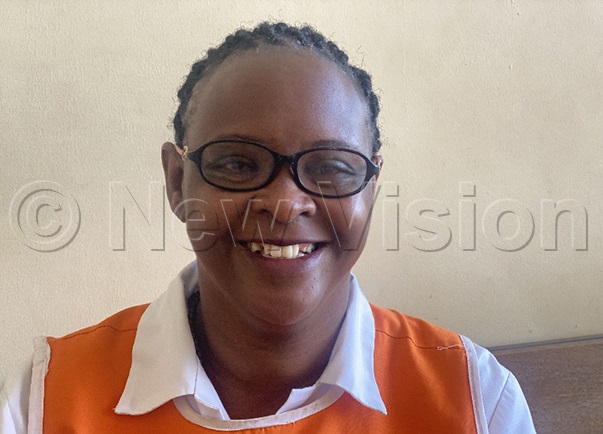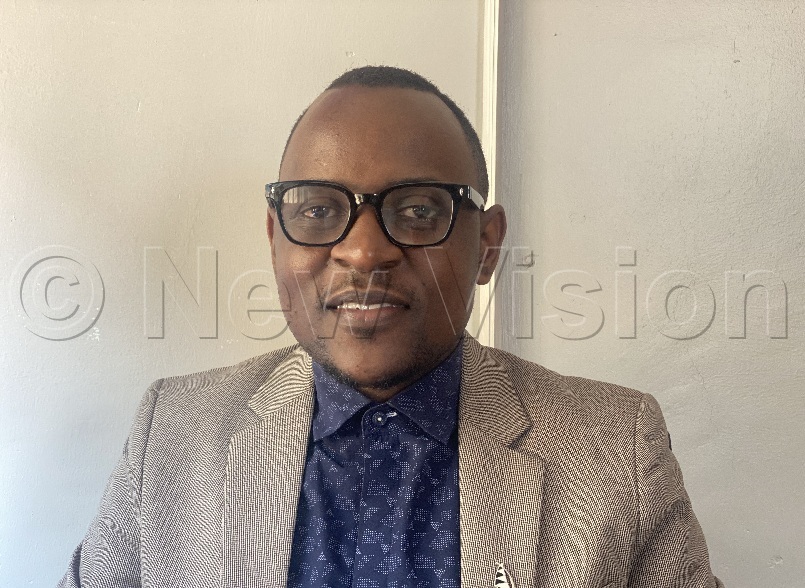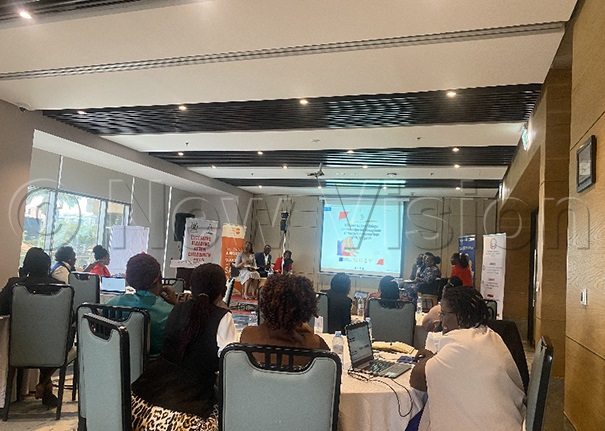A life on the line: Surviving postpartum hemorrhage
Postpartum hemorrhage (PPH), which is severe bleeding that can occur within 24 hours up to 12 weeks after childbirth, is the leading cause of maternal mortality worldwide.
Participants pose for a group photo after the Midwives dialogue. (Credit: Jacky Achan)
__________________
The labour suite at Kawaala Health Centre IV is small, busy, and bustling with urgency. I step in and am immediately struck by the intensity of it all.
In a small corridor, a midwife bends beside a mother, guiding her through the final moments of labour. Beyond, the main room stretches out with more beds, each occupied by a woman in labour. Some cry out in pain, others groan quietly.
Midwives move with skillful efficiency, delivering babies, wrapping them, and placing them in tiny warming beds. Amidst the chaos, it is clear: this is a place where life begins, and the staff navigate it all like clockwork.
The in-charge midwife greets me and leads me to Flora Komujuni, 32, a mother who suffered a postpartum hemorrhage (severe bleeding after giving birth) and has agreed to share her story.
“When I first felt labour pains at home, I tried not to panic,” Flora begins.
“I told myself not to go to the hospital too early, so I stayed home, walking around to ease the discomfort. By 1 pm, the pain had grown stronger, so I decided to come in. At first, the contractions were mild, coming and going, but once I arrived, they intensified. The midwife asked me to walk around the hospital until it was time to push. When I felt ready, I moved to the bed, and the midwife helped me deliver my baby boy smoothly.”
After delivery, Komujuni was moved to a chair nearby to begin breastfeeding, while the midwives continued attending to other mothers. “I was breastfeeding when I suddenly noticed I was bleeding,” she recalls. “I called the midwife, who told me to sit on a bucket and pass urine. I ended up passing so much blood that I lost consciousness.”
When she woke, Komujuni found herself on a hospital bed with drips and injections. She also had a catheter inserted during treatment. “I shivered and shook, but it gradually eased. I am so grateful to God and to the medics for saving me,” she said.
Komujuni was stable and out of immediate danger. She had no previous history of postpartum hemorrhage, and this was her fifth child.
“My now second last born is six years old. I was on family planning, but the methods I tried gave me side effects, so I stopped. I wasn’t expecting this pregnancy,” she says. Komujuni plans to find a suitable family planning method to avoid unplanned pregnancy, “but If I get pregnant again, I will have to be strong,” she says.
Christine Kihembo, the in-charge midwife at Kawaala HC IV, says that Komujuni’s case was a typical example of postpartum hemorrhage following a normal delivery.
Christine Kihembo, the in-charge midwife at Kawaala HC IV. (Credit: Jacky Achan)
“Her labour progressed well, and the second stage (delivery of the baby) was managed by the night team. Because the labour suite is always busy, we often have mothers initiate breastfeeding on chairs nearby. After breastfeeding, Komujuni began bleeding heavily and went into shock. We administered medication and care to manage the hemorrhage. Her bleeding became minimal, and she was monitored closely in the labour suite for another hour before being moved to the postnatal ward.”
Komujuni’s experience is a reminder of how quickly childbirth can become dangerous, even for women with no prior complications.
👉 A life on the line: Surviving postpartum hemorrhage
Understanding PPH
Postpartum hemorrhage (PPH), which is severe bleeding that can occur within 24 hours up to 12 weeks after childbirth, is the leading cause of maternal mortality worldwide.
Defined as a blood loss exceeding 500 millilitres after delivery, PPH affects about 14 million women annually and causes roughly 70,000 deaths, according to the World Health Organisation.
It accounts for more than 20% of maternal deaths globally, and often survivors require urgent surgical interventions, and it can leave long-term reproductive complications.
Despite global efforts to end preventable maternal deaths by 2030, many countries remain off-track to meet SDG-3 targets.
In Uganda, data show, PPH is the top cause of maternal mortality, responsible for about one in three deaths in 2022/23.
Major risk factors include cesarean deliveries, multiple pregnancies, and limited access to blood, drugs, and essential supplies.
Kawaala Health Centre IV: A frontline battle
At Kawaala Health Centre IV, one of Kampala’s busiest maternity facilities, PPH is a challenge.
Christine Kihembo, a midwife and head of the maternity department, says the centre receives two to three PPH cases monthly.
“In July, we lost a mother referred after a cesarean section. She was anemic, and despite receiving blood, traffic delays during transfer cost her life,” Kihembo recalls.
She notes that PPH cases are worsened by use of herbal medicine, misuse of drugs like misoprostol, and limited monitoring due to space and staffing shortages.
Many mothers arrive after taking unprescribed drugs to speed labour, often resulting in uterine rupture, retained tissue, or severe bleeding.
One room serves as admission, labour, and post-delivery space, and family planning remains underused, increasing high-risk pregnancies.
Despite challenges, Kihembo’s team is improving outcomes. High-risk mothers are screened during antenatal visits, all undergo hemoglobin testing and blood grouping, and midwives are trained on use of new drugs like Heat-Stable Carbetocin for PPH Prevention and the E-MOTIVE protocol, which provides step-by-step guidance for managing PPH.
With better access to blood, new and essential medicines, severe cases have dropped sharply. “We used to report 10–15 cases a month to Kawempe; now most are managed here and are less severe,” she says.
Shortages of resuscitation fluids persist, but emergency drug supplies are improving, ordered now based on patient numbers. Nearby herbalists have been removed with support from security, while Village Health Teams educate communities about the dangers of unprescribed drugs and herbal remedies.
System-Level interventions and awareness campaigns
Dr Padric Nyanzi, an obstetrician-gynaecologist, Chairperson for Maternal and Perinatal Death Surveillance and Response (MPDSR) across all Kampala City Council Authority (KCCA) facilities, and doctor in charge of Kawaala Health Centre IV, is at the forefront of Kampala’s efforts to strengthen maternal care.

Dr Padric Nyanzi. (Credit: Jacky Achan)
In August, health workers, communities, and policymakers came together for the annual Postpartum Hemorrhage (PPH) Awareness Month under the theme, “Ending maternal death due to excessive bleeding after birth: our collective responsibility.”
Led by the Ministry of Health with support from partners such as UNFPA, the campaign targeted both communities and health workers, emphasising early recognition of danger signs, birth preparedness, and timely hospital access.
For Dr Nyanzi, preventing PPH requires action on two fronts: empowered patients and prepared health systems.
Survivor stories were shared during antenatal visits, helping expectant mothers and their partners understand the dangers of delays, unregulated drugs, and unsafe birthing practices.
Partner involvement was emphasised as well, with husbands and caretakers encouraged to attend clinics and learn how to recognise danger signs and act quickly. Community outreach, radio talk shows, and church programs extended this awareness beyond hospital walls.
Training and mentorship
Central to Dr Nyanzi’s strategy is mentorship. Each maternity ward now has designated PPH champions, midwives who mentor colleagues, provide peer updates, and ensure emergency kits are stocked daily with essential drugs, gloves, catheters, and other essential supplies.
Continuous medical education every six weeks reinforces best practices and strengthens emergency preparedness.
Partnership support has been key. UNFPA supplies essential medications like Heat-Stable Carbetocin, facilitates staff training, and supports survivor engagement programs. USAID and Save the Children have contributed to awareness campaigns and capacity-building.
At Kawaala, PPH kits are checked daily to ensure readiness for emergencies, guaranteeing rapid treatment when mothers arrive bleeding.
Understanding causes and patient roles
Dr Nyanzi explains that PPH is primarily caused by the four Ts: Tissue (retained placenta or clots), Tone (uterine atony, when the uterus fails to contract), Tears (vaginal or cervical tears), and Thrombin (clotting disorders).
Patient decisions also influence risk; refusing cesarean sections against medical advice, concealing previous complications, or delaying hospital visits can all lead to severe bleeding.
Patient decisions also play a critical role. Refusing cesarean sections, concealing previous complications, or delaying hospital visits can all increase the risk of severe bleeding.
Antenatal care is therefore essential to identify risks, educate mothers, and plan safe deliveries. Partner involvement also strengthens outcomes by enabling families to recognise warning signs and act quickly.
“When expectant mothers and their families understand the danger signs, plan for birth, and seek care early, their chances of survival rise,” says Nyanzi. “At the same time, health facilities must be ready with trained staff, essential medicines, blood supplies, and functioning referral systems.”
Progress and outcomes
At Kawaala Health Centre IV, the number of PPH cases has dropped significantly, from about 20 per month to an average of three to six, according to Dr Nyanzi.
Improved referral pathways, better blood availability, trained midwives, and ready emergency kits have all contributed to increased maternal survival.
Funding for emergency drugs has increased significantly, from sh9.2 million shillings bi-monthly to sh45 million as of today, whereas UNFPA support has provided essential medicines to manage PPH and staff trainings, including the E-MOTIVE programme.
Even with these improvements, Kawaala remains a high-burden facility, delivering 850 to 900 babies per month post-COVID-19, compared to about 300 before the pandemic. Each birth carries potential risk, making preparedness essential.
Even with robust systems, each maternal death is deeply felt and taken seriously. “For us, one maternal death is too many,” Dr Nyanzi emphasises.
Remaining challenges
Despite the progress, gaps remain. Infrastructure is limited. Kawaala still lacks a dedicated labour ward and proper first and second stage rooms. Staffing shortages persist, while community education continues to struggle with under-motivated VHTs and accessibility issues.
Yet, the decline in PPH cases demonstrates the effectiveness of coordinated, data-driven interventions.
“The work is informed by statistics and experience,” says Nyanzi. “We track numbers, compare outcomes, and act on gaps. Improving from 20 cases a month to just three to six is progress. We are not perfect, but every maternal life saved is a victory.”

Midwives dialogue. (Credit: Jacky Achan)
The critical role of midwives
At a high-level midwifery dialogue in Kampala on September 4, UNFPA’s Programme Coordinator for Sexual and Reproductive Health, Juliana Lunguzi, called midwives the foundation of Uganda’s maternal health system, noting that stronger training and support could prevent up to 67% of maternal deaths.
Citing the State of the World’s Midwifery 2021 report, she cautioned of a 300,000 midwife shortage in East and Southern Africa and urged investment in midwife-led care and family planning, which could avert 30% of maternal deaths by reducing high-risk pregnancies.
Lunguzi urged midwives to see themselves as leaders and “architects of change,” shaping maternal health outcomes through advocacy, decision-making, and improved service delivery. She stressed that prevention must go beyond delivery rooms.
The dialogue organised by the Ministry of Health and the National Midwives Association of Uganda focused on midwifery leadership, emergency readiness, and integrating family planning into care.
Through the Safe Birth Mission, supported by the European Union and UNFPA, the Ministry is training midwives to manage complications like PPH and improve access to essential supplies. Officials emphasised that empowering midwives is key to ending preventable maternal deaths.
A continuing fight
The battle against PPH continues, but coordinated, data-driven interventions are saving lives. At Kawaala Health Centre IV, staff training, community outreach, stronger referrals, and the dedication of midwives like Christine Kihembo are cutting maternal deaths.
“The fight continues daily,” says Dr Nyanzi. “We are not perfect, but reducing cases from 20 a month to just a few is progress. Every mother who survives is a victory.”
For survivors, these efforts bring renewed hope. “If I get pregnant again, I will have to be strong, but I plan to find a suitable family planning method,” says Komujuni. Kihembo adds, “We will counsel her to reduce future risks.”